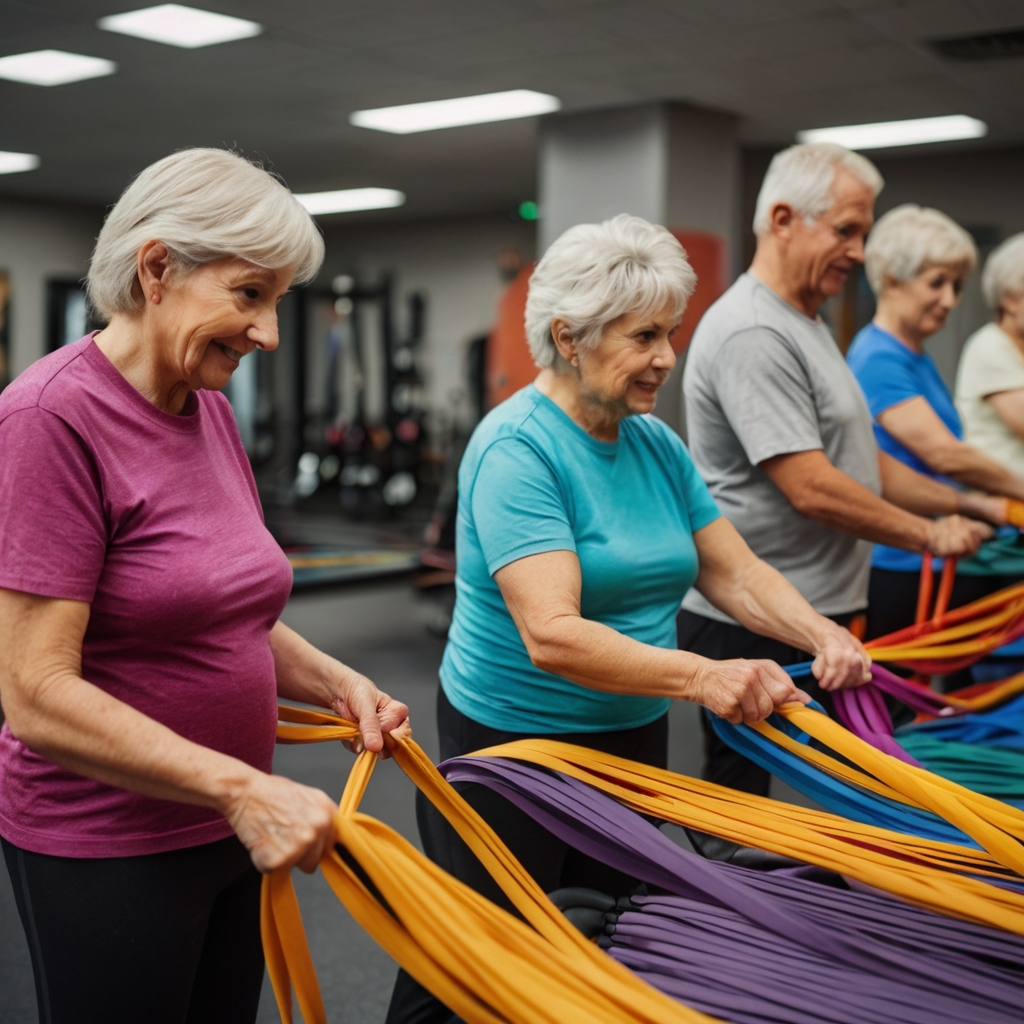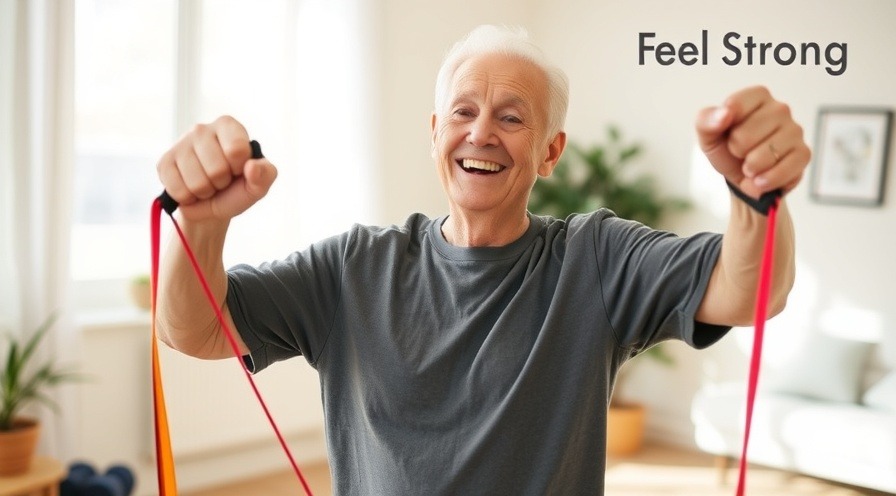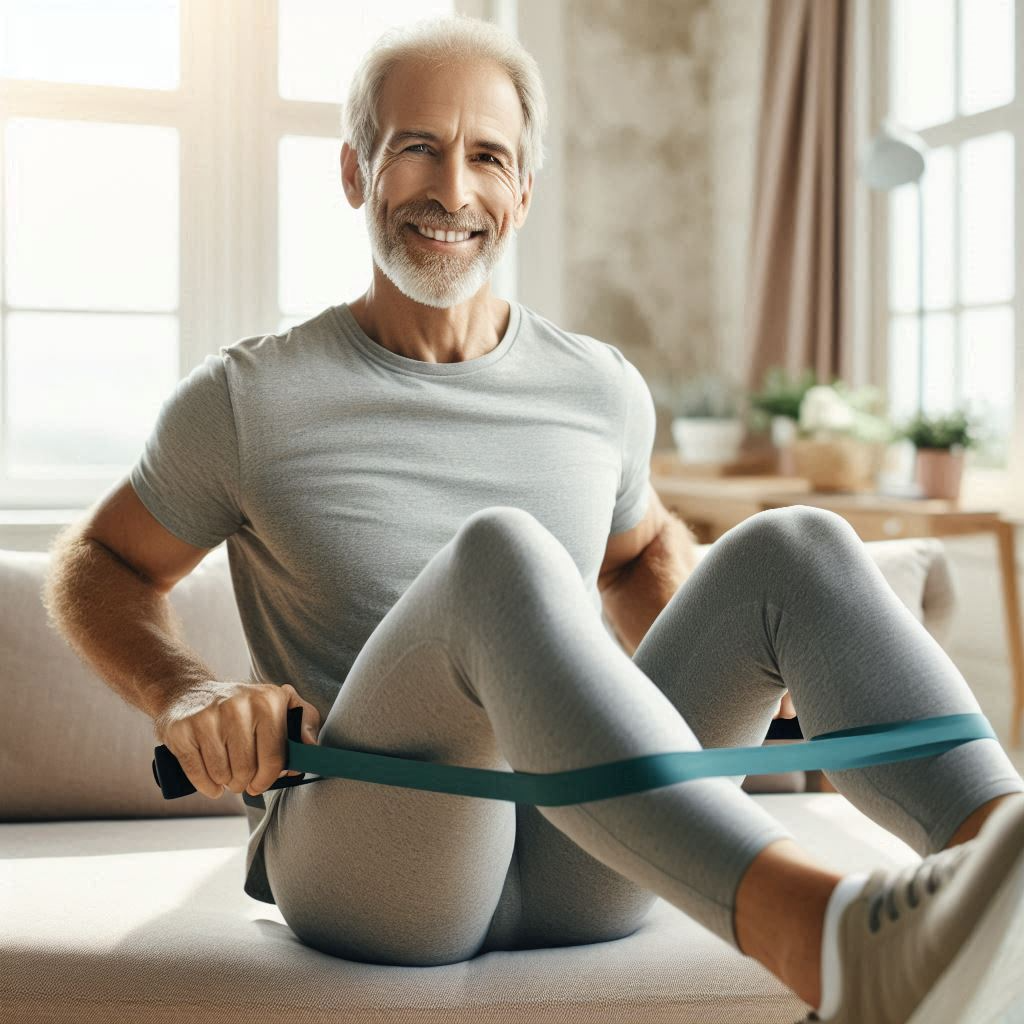
Did you know that more than 60% of older adults lose significant muscle mass every decade after turning 50?
This hidden truth has a powerful impact on daily living, from making grocery trips harder to climbing the stairs feeling twice as steep. Fortunately, there’s a simple, effective tool to help change the story— resistance band exercises for older adults can help you rebuild, maintain, and enjoy stronger muscles and a more independent life well into your golden years. Let’s unlock the secrets to safer, easier workouts—and show you practical steps and examples to get started!
Over 60% of Older Adults Lose Muscle Each Decade – How Resistance Band Exercises for Older Adults Can Help You Stay Strong
Losing muscle mass isn’t just about appearance; it can affect your balance, stamina, and ability to perform basic daily activities . With age, muscle fibers shrink and recover more slowly, putting older adults at risk for weakness and falls. But here’s the good news—studies reveal that you can improve your strength, flexibility, and coordination at any age. Plus, resistance band exercises make it simple and accessible, even if you’ve never used gym equipment before.
Band exercises use elastic bands to create gentle tension against your movements. This resistance stimulates your muscle groups —from the upper body to leg muscles and your core. Resistance band exercises can be adapted for anyone’s fitness level, which means you can begin safely and progress at your own pace. Practical examples include seated bicep curls and seated leg presses , simple moves that support daily strength. Whether your goal is carrying groceries, gardening, or simply staying steady on your feet, these band exercises for seniors give you a reliable foundation for living actively at any age.

Why Resistance Band Exercises for Older Adults Are Essential for Healthy Aging
The journey to healthy aging centers around maintaining your muscle strength and keeping both body and mind engaged. A decrease in muscle mass often leads to slowed movements and reduced independence. Enter resistance band exercises —these low-impact, joint-friendly movements allow you to work multiple muscle groups with one simple tool. They’re portable, cost-effective, and can be used anywhere—from your living room to the park.
Unlike heavy weights, resistance bands provide progressive resistance, so the workout grows with you as you build strength and confidence. This flexibility makes band exercises ideal for older adults just starting or returning to fitness routines. Even small improvements in strength and flexibility can make a significant difference in things like getting out of chairs, walking longer distances, and even reducing the risk of falling.
If you're interested in focusing on specific muscle groups, incorporating targeted routines can be especially beneficial. For example, adding a few simple arm exercises designed for seniors can further enhance your upper body strength and support daily activities. Explore these easy arm exercises for seniors to complement your resistance band workouts and build confidence in your movement.
Understanding the Science: Strength Training and Aging
As we age, our bodies naturally lose muscle mass—a process called sarcopenia. This loss can be accelerated without strength training . Fortunately, research shows that resistance band exercises are effective in maintaining and increasing muscle strength for seniors. Bands offer a safer way to add resistance because they don’t strain joints in the same way as traditional weights. Adding these routines helps older adults counteract the effects of aging, keeping muscle fibers active and stimulating muscle growth.

Muscle Strength, Flexibility, and the Role of Resistance Band Exercises
The two pillars of healthy movement for older adults— muscle strength and flexibility —are both improved through regular band exercises . Muscles support joints, protect bones, and make everything from tying shoes to carrying bags easier. Bands are especially effective because they allow older adults to gradually adjust their resistance level, which means you can choose the challenge that fits your comfort and experience.
Flexibility is just as crucial as strength, helping maintain range of motion, smooth gait, and pain-free daily activities. Resistance band exercises can stretch and strengthen at the same time, offering a two-in-one solution. By improving flexibility and muscle strength together, seniors gain more confidence in movement and reduce their risk for injury. From bicep curls to standing hip abductions , the variety of exercises keeps things fresh while ensuring you’re getting a full-body workout.
"Strength doesn’t come from what you can do. It comes from overcoming the things you once thought you couldn’t." – Rikki Rogers
Choosing the Right Resistance Bands: Tips for Older Adults
Selecting the right resistance band is the foundation of a safe and effective workout. There are several types of resistance bands —each suited to different needs and experience levels. Some bands are better for upper body moves, while others work well for lower body strength or movement limitations. The ideal choice for older adults typically involves bands with handles or soft fabric for comfort and a secure grip. This boosts safety, performance, and enjoyment during every session.
Bands come in a range of resistance levels , usually color-coded from light to extra heavy. For beginners or those with joint issues, lighter tension bands are a smart choice. As you build strength and confidence, gradually increase to medium or heavy resistance bands. Always check the manufacturer’s guide, and remember your own comfort and mobility matter more than the band’s color or brand.
Different Types of Resistance Bands and Resistance Levels for Seniors
There are several resistance band types you’ll encounter while shopping. Loop bands are continuous circles and excellent for lower body moves like leg presses and side steps. Tube bands with handles offer easy grip and adjust for upper and lower limb exercises.
Fabric bands are gentle on the skin and don’t roll or pinch, making them a favorite for older adults. The trick is finding a resistance level that allows movement with effort but without strain—always start lighter and progress with comfort.
Choosing between resistance bands is easier once you know your goals. Experience is key, so sample a few and see how your joints and muscles respond during practice moves like a gentle bicep curl or leg press. It’s worth noting that some bands, especially latex-free or fabric options, are designed specifically for seniors’ unique needs, such as grip strength or skin sensitivity.

Comparison of Resistance Bands for Older Adults |
|||
Type |
Pros |
Cons |
Best For |
|---|---|---|---|
Loop Bands |
Versatile, compact, great for lower body |
Can roll up, may pinch skin |
Leg exercises, side steps, glute bridges |
Tubes with Handles |
Easy grip, good for upper body, adjustable |
Can snap with overuse, less portable |
Bicep curls, chest press, rows |
Fabric Bands |
Comfortable, no rolling or slipping, durable |
Limited stretch, less variety |
Hip abductions, squats, gentle core work |
How to Test Resistance Level and Safety Considerations
To test your resistance band’s level, perform a basic exercise—such as a bicep curl or leg press—using slow, controlled motion. If you can’t complete 10–12 reps with good form, the resistance may be too high. For beginners or those new to exercises for seniors , choose bands offering a lighter resistance so that you can master movement and form. Remember—never continue if you experience sharp pain, and check the band for cracks or wear before every session to prevent accidental snapping.
Safety comes first when using resistance bands . Maintain a secure grip, anchor your band under a foot in front if standing, or around a stable chair, and always return to your starting position in a controlled way. If in doubt, ask a healthcare provider or certified trainer to check your band exercise technique before starting your full workout.
Getting Started with Resistance Band Exercises for Seniors: Safety, Form, and Warm-Up
Ready to begin? The first step in any new exercise program should be safety. With resistance band exercises for older adults , it’s essential to choose appropriate resistance, learn proper form, and warm up muscles before increasing load or intensity. A proper warm-up increases blood flow, reduces injury risk, and primes joints and muscles for activity. Remember, exercising is not a race— slow, controlled movements deliver better results and prevent setbacks.
Each routine should start with movements familiar to your daily life, like reaching, pushing, or stepping. Start with easy moves to become confident, then expand to new band exercises as comfort grows. Most importantly, celebrate progress, even if it’s just a few more reps each week.
Consulting Your Healthcare Provider Before Starting Band Exercises
Always consult your healthcare provider before starting any new resistance band exercise program, especially if you have health concerns, balance issues, or chronic conditions. Your doctor can help you set safe boundaries and collaborate on adjustments if needed. This consultation builds peace of mind as you embark on your fitness journey.
Ask your healthcare provider about which resistance bands and exercises suit your specific needs, whether it’s heart health, arthritis, or post-injury recovery. A simple conversation could ensure each band exercise supports both short-term gains and long-term well-being. This team approach is key to a sustainable routine for older adults .

Essential Warm-Up Moves Using Resistance Bands
Warm-ups are critical for preparing muscles and joints for safe workouts. Begin every resistance band exercise session with at least 5–10 minutes of movement such as shoulder rolls, gentle marches, and light stretches using a resistance band . Try these simple warm-up moves:
Band Shoulder Circles: Hold the band between your hands, arms stretched forward, and slowly create large circles—activates shoulders and upper back.
Band Marches: Hold the band under your feet, gently march in place, and pull the band upward as you raise each knee.
Gentle Chest Openers: Pull the band apart in front of your chest for increased blood flow and mobility.
These warm-up activities increase joint lubrication and muscle temperature, paving the way for more effective and safer band exercises for seniors .
Video Demonstration: Full-Body Warm-Up for Resistance Band Exercises for Older Adults
Full-Body Resistance Band Exercises for Older Adults: Easy Strength Tips
Harness the power of resistance band exercises for older adults to work every major muscle group . A full-body approach ensures you balance strength, stability, and mobility—exactly what’s needed for better senior living and independence. Whether seated or standing, these routines are adjustable and adaptable.
Always start with exercises that use your own body weight for orientation, then add the resistance band. This order helps maintain proper form and builds confidence in movement. The following sections break down the essential routines for upper body , lower body, and core with safe and simple instructions.
Upper Body Band Exercises: Seated and Standing
Bicep Curl and Bicep Curls with Resistance Band: Hold the band under your feet with palms facing upward and slowly curl arms toward shoulders, keeping elbows close to your rib cage. This strengthens biceps and improves grip.
Shoulder Press: Sit or stand with the band anchored under your seat or feet. Grasp handles or ends and press arms overhead, engaging shoulders and upper back.
Chest Pull-Apart: Hold the band at chest level with straight arms and pull the band until your shoulder blades squeeze together, strengthening the back and chest.
Seated Row: Loop the band around your feet while seated, grasp ends, and pull elbows back as if rowing—targets upper back and posture muscles.
These band exercises for seniors can all be performed in a chair or standing, offering maximum flexibility for all levels of mobility. Aim for slow, steady repetitions (10–15 is a great starting point) and focus on quality movement over quantity.

Lower Body Resistance Band Exercise for Seniors
Seated Leg Press: Sit tall, loop the band around your feet, and push your feet forward, extending your legs. This works four key leg muscles used in walking and standing.
Standing Hip Abductions: Anchor the band around your ankles or above your knees, stand tall, and slowly move one leg to the side. This strengthens hips and improves balance for fall prevention.
Glute Bridge with Band: Lie on your back with knees bent, band just above knees, and push hips upward into a bridge. This exercise supports strong hips, lower back, and balance—vital for daily activities.
Each lower body move teaches your muscles to work in new patterns, defending against age-related muscle loss. Start slowly, and as strength increases, use bands with more resistance for greater muscle gains.

Core Stability and Posture: Resistance Band Exercises for Seniors
Standing Side Steps: Place band around lower thighs, stand with feet hip-width, and step side to side, keeping knees bent. This move activates hip stabilizers and core for balance.
Seated Band Rotations: Sit tall, anchor band at your feet, hold ends at chest, rotate core gently side to side for better spinal mobility.
Back Extensions: Anchor band with both hands behind your back and, from a seated or standing start, gently extend chest forward, working lower and mid-back muscles.
Improving core stability translates directly to improved posture and easier movement during daily tasks. These band exercises keep your foundation strong, helping protect the spine and support overall function.

Sample Weekly Workout Plan: Band Exercises for Seniors
Building a consistent schedule enhances progress and confidence. Below is a starter weekly plan for resistance band exercises for older adults —adapt sets and repetitions as you become stronger. Listen to your body, and always rest between sessions for optimal muscle recovery.
Resistance Band Exercise Weekly Schedule for Older Adults
Day |
Exercise |
Sets |
Reps |
|---|---|---|---|
Monday |
Bicep Curl (Seated/Standing), Shoulder Press |
2 |
10–15 |
Wednesday |
Seated Leg Press, Hip Abductions |
2 |
10–15 |
Friday |
Chest Pull-Apart, Seated Row, Standing Side Steps |
2 |
10–12 |
Saturday |
Glute Bridge, Seated Band Rotations, Back Extensions |
1–2 |
10–12 |
Step-by-Step Routine: Follow Along with Resistance Band Exercises for Beginners (Seniors Edition)
Tips for Maximizing Safety, Comfort, and Results With Resistance Bands
Always check resistance bands for damage before each workout
Gradually increase the resistance level as you progress
Focus on slow, controlled movements for muscle strength and stability
Use a sturdy chair or wall for balance when needed
Consistency is more important than intensity when it comes to band exercises for seniors . By putting safety first and progressing gradually, you reduce injury risk and build sustainable habits. Remember, supportive environments—like classes or partner workouts—can increase motivation and accountability.
How to Modify Band Exercises for Seniors With Mobility Limitations
Adaptation is key for anyone experiencing balance issues, chronic conditions, or simply recovering from injury. Many resistance band exercises can be performed seated, allowing older adults to work all major muscle groups without risk of falling. For example, a seated bicep curl offers the same benefit as standing, and seated rows improve upper body strength safely.
For those using wheelchairs or with limited mobility, focus on exercises where the resistance band can be easily anchored—such as looping around a foot or chair base. Resistance levels should be tailored for smooth motion, not strain. The goal is functional movement—if a full extension isn’t possible, perform smaller, pain-free motions and build up gently with guidance from a healthcare provider .

Frequently Asked Questions about Resistance Band Exercises for Older Adults
Should seniors use resistance bands?
Resistance band exercises for older adults are recommended because they are low-impact, improve muscle strength, and help maintain functional abilities safely.
What type of resistance bands are best for seniors?
The best resistance bands for seniors are lightweight, latex-free, and have handles or fabric for a better grip and safety.
What is the best resistance training for seniors?
The best resistance training for seniors combines resistance band exercises, bodyweight moves, and flexibility work to support muscle strength and mobility.
How do you use resistance bands over 60?
Start with easy resistance band exercises, focus on proper form, and follow routines tailored to older adults for safe, effective results.
Empower Your Health: Start Resistance Band Exercises for Older Adults Today
Ready to build strength and independence? Grab a resistance band and begin your healthy aging journey with simple steps—your future self will thank you!
As you continue to build strength and confidence with resistance band routines, consider broadening your approach to overall wellness. Embracing a holistic view of health means staying informed about other factors that can impact your vitality as you age. For a deeper dive into maintaining your well-being and recognizing when to seek additional support, discover these key insights on seeking professional help for mental health . Taking proactive steps—both physically and emotionally—can empower you to enjoy a more active, fulfilling life at every stage.
Sources
CDC – https://www.cdc.gov/physicalactivity/basics/older_adults/index.htm
NCBI – https://www.ncbi.nlm.nih.gov/pmc/articles/PMC6784279/
National Institute on Aging – https://www.nia.nih.gov/health/exercise-physical-activity
Incorporating resistance band exercises into your routine can significantly enhance strength, flexibility, and overall health as you age. For a comprehensive guide, consider exploring the article “6 Easy Resistance Band Exercises For Seniors” by TerraBella Senior Living, which outlines simple exercises tailored for older adults. ( terrabellaseniorliving.com ) Additionally, “8 Easy Resistance Band Exercises for Seniors from an Occupational Therapist” by Expert Fitness Supply offers professional insights into effective routines. ( expertfitnesssupply.com ) These resources provide valuable information to help you safely and effectively incorporate resistance band exercises into your daily life.
 Add Row
Add Row  Add
Add 




Write A Comment